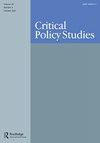The U.S.-Mexico border as liminal space: implications for policy and administration
IF 2.4
3区 社会学
Q1 Social Sciences
引用次数: 1
Abstract
ABSTRACT This paper examines the U.S.-Mexico border by exploring the concepts of otherness and liminality in light of restrictive immigration discourses that otherize undocumented Hispanics as a ‘threat to the whole.’ Through the use of ethnographic sources this paper argues that face-to-face interactions unveil a much more complex picture of life in the borderlands. The border emerges as a diverse realm of pull and push forces, with most people experiencing resistance and aversion at some point of their lives and opportunity and mobility at others. The liminal – understood as the in-between space along nation-state borders – helps account for the continuously transitional borderland experiences where both possibility and heightened risk may be at stake. Finally, the author suggests ways in which experiential understanding can help foment a more democratic and effective border policy making and implementation process.美墨边界作为边界空间:对政策和管理的影响
摘要本文从限制性移民话语的角度,通过探索另类性和有限性的概念来审视美墨边境,这些话语将无证西班牙裔视为“对整体的威胁”通过使用人种学资料,本文认为面对面的互动揭示了边境地区更复杂的生活图景。边境是一个由拉和推力量组成的多样化领域,大多数人在生活的某个阶段都会经历阻力和厌恶,而在其他阶段则会经历机会和流动。边界——被理解为民族国家边界的中间空间——有助于解释持续过渡的边界地区经历,在这种经历中,可能性和风险都可能受到威胁。最后,作者提出了经验理解有助于推动更民主、更有效的边境政策制定和实施过程的方法。
本文章由计算机程序翻译,如有差异,请以英文原文为准。
求助全文
约1分钟内获得全文
求助全文

 求助内容:
求助内容: 应助结果提醒方式:
应助结果提醒方式:


